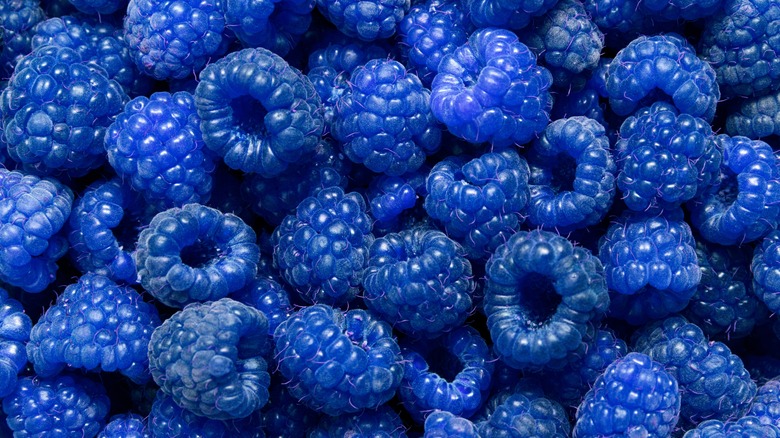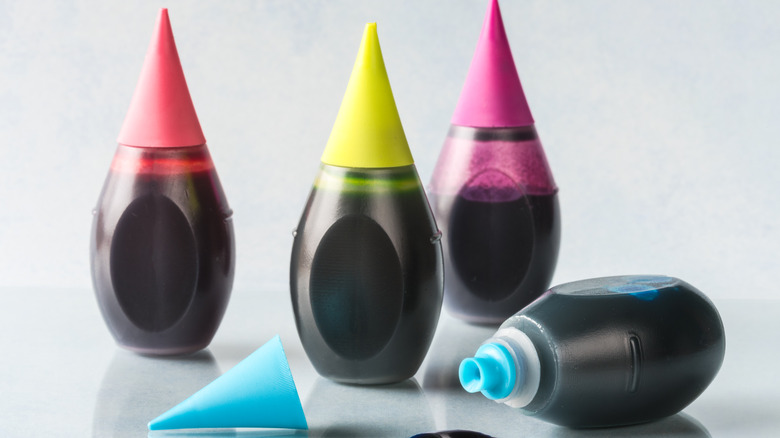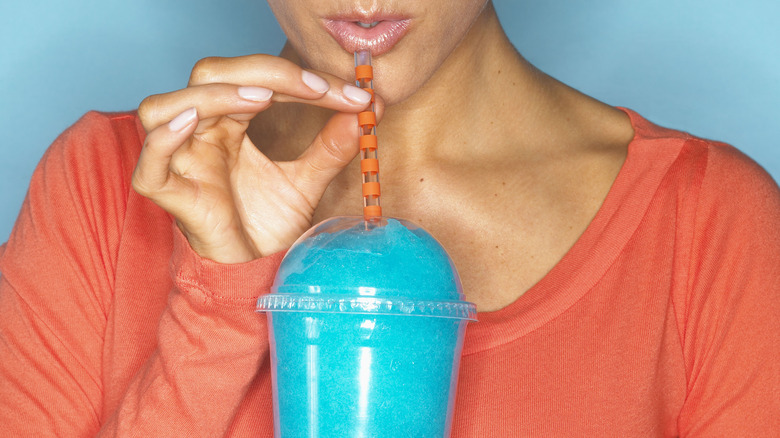How Blue Raspberry Flavor Came To Be
Of all the artificial flavors out there, blue raspberry feels the least authentic. At least other artificially-flavored products make the effort to match the color of whatever they're emulating — cherry is red, apple is green, grape is purple, etc. Raspberry being the color of Windex seems like a stunt Willy Wonka would pull for April Fool's Day. But believe it or not, there's actually a completely logical explanation for blue raspberry's existence.
Some have claimed that blue raspberry flavor is inspired by a real fruit — the whitebark raspberry (aka blackcap raspberry) — which ripens into a deep purple color. However, these don't look anything like the neon-colored flavor we find in candies and ice pops. They're more like standard blackberries, and they're also rather rare, growing wild along the West Coast of the United States, but not widely cultivated for commercial purposes. Truthfully, there's no link between the "real" blue raspberry and the artificial flavor that's become so popular. The actual inspiration was far more practical.
The thing is, there are just too many red fruits. On top of raspberries, you've got cherries, strawberries, and watermelon. In order to distinguish each flavor, confectioners settled on a basic standard: Cherry is dark red, strawberry is light red, and watermelon is pink. Raspberry-flavored candies used to have their own shade of red food dye — a dark crimson shade called amaranth. But it turns out amaranth was hiding a dark secret, one that forced confectioners to make a dramatic change in their color palette.
The original dye used for raspberry flavor is now illegal
Amaranth has another name — FD&C Red No. 2 — and it was once a commonly-used food dye, until questions about its safety arose. In 1976, the Food and Drug Administration banned the use of Red No. 2 after research showed that it caused cancer in lab rats. There's still some uncertainty over how dangerous Red No. 2 really is for human consumption — and it is still legal in most other countries. But after the FDA ruling, American confectioners had to find a new color for raspberry flavor. Fortunately, an alternative was already gaining popularity.
The first blue raspberry product ever released was a cotton candy flavor made by Gold Medal in 1958. The inspiration for this choice has been lost to history, but it laid the groundwork for two other companies that would take blue raspberry mainstream. The first was ICEE, which released a raspberry flavor in the early 1970s. Since the only other flavor at the time was bright red cherry, the company decided to use the opposite end of the color wheel and make the raspberry ICEE blue. The dye of choice, Blue No. 1 (which has not been linked to cancer), is now the standard shade for blue raspberry treats. Around the same time, Otter Pops debuted a blue raspberry flavor. Together, these frozen treats got America hooked. Now, you'll find blue raspberry in ice pops, beverages, snow cones, and of course, it's the best Jolly Rancher flavor.
What is blue raspberry flavor actually made from?
Blue raspberry-flavored items obviously look like they have nothing in common with real raspberries, and the same can be said of their flavor. Ask yourself, if you did a blind taste test of Jolly Rancher flavors, with no color to guide you, would you really be able to distinguish which one is raspberry? Probably not, because the reality of artificial flavors is that they have very little to do with the things they're mimicking.
Most of what we call "flavor" actually comes from smell. Fruits contain hundreds of fragrant chemicals that flavorists can recreate in labs, and they only need to match one or two of these chemicals to get a decent approximation that's close to the real source. Artificial flavors (and natural ones too, for that matter) come from esters — chemical compounds made by mixing different types of alcohol and acid. For example, if you mix ethanol with butanoic acid, you get ethyl butanoate, which is used for pineapple flavoring. You don't need to worry about getting tipsy from artificial flavors, because the chemical reaction eliminates the alcohol's intoxicating properties.
There is no single ester for blue raspberry flavor. Instead, it's typically made by combining esters of cherry, banana, and pineapple flavors. So, in short, blue raspberry is made from a hodgepodge of flavors and colors, none of which have anything to do with actual raspberries. It's the Frankenstein's monster of the confectionery world, but gosh darn if it isn't delicious.


